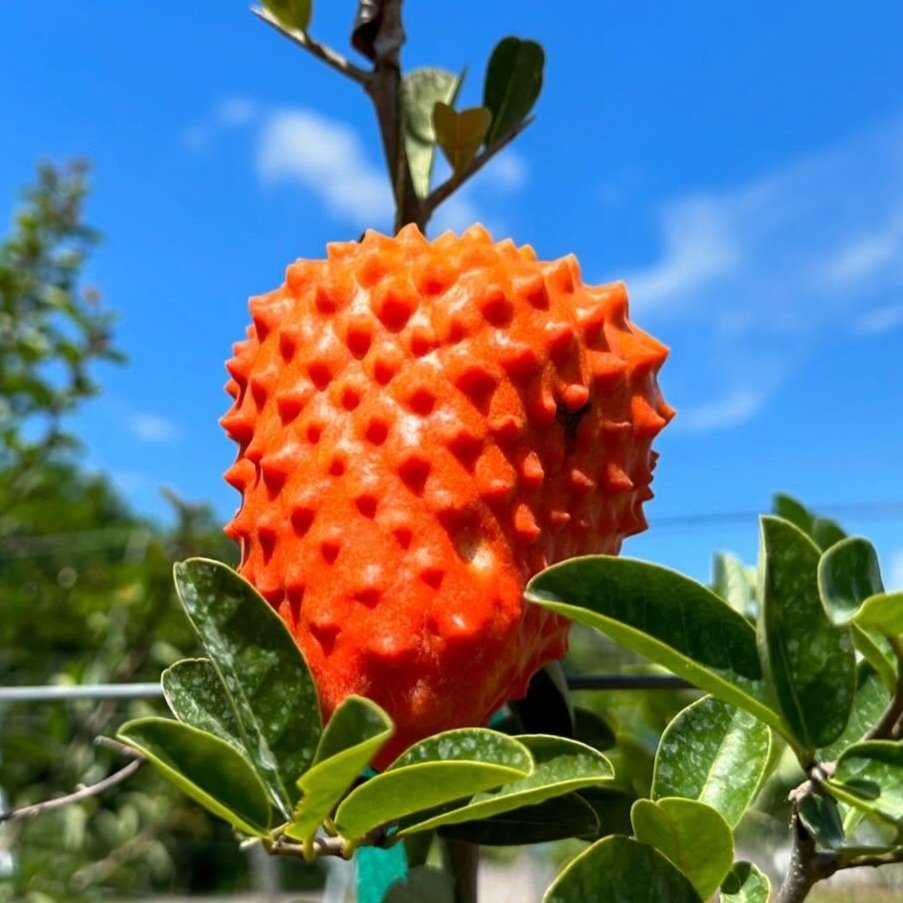Annona Spinescens
Seeds were imported from Brazil. Rare species that inhabits the caatinga of the state of Mato Grosso do Norte, Piauí and nearby along the São Francisco River in the state of Minas Gerais and Bahia, Brazil. Small tree 3 to 5 meters tall, with a globose crown and thorny branches, with a cylindrical trunk with rough, grayish bark; often branching from the base. The branches are graphite-colored and have very sharp, opposite shoots that look like thorns, which is why it received its scientific and popular name. This is a rare and slow-growing plant, but once established in an orchard it can withstand drought and frosts of up to minus 3 degrees Celsius. It can be grown throughout Brazil, at any altitude and always in full sun. It likes different types of soil, as long as they are deep and well-drained, such as sandy soils, red or yellowish soils and even clay soils free from waterlogging. It likes a little moisture and decomposed organic matter, and the pH should be between 5.0 and 6.2. It begins to bear fruit after 2 to 3 years, depending on the climate and cultivation practices. The fruits are delicious and can be eaten fresh, especially if left in the refrigerator for a few hours. The tree is ornamental and great for decorating small gardens. The ripe fruits can be pulped in a sieve and the pulp can be frozen or used to make delicious juices, ice cream and sweets. As it is a rare species that is in danger of extinction, it should not be missing from any type of plant collection.
You are purchasing a single seed. Seeds are shipped in humid vermiculite.
Seeds were imported from Brazil. Rare species that inhabits the caatinga of the state of Mato Grosso do Norte, Piauí and nearby along the São Francisco River in the state of Minas Gerais and Bahia, Brazil. Small tree 3 to 5 meters tall, with a globose crown and thorny branches, with a cylindrical trunk with rough, grayish bark; often branching from the base. The branches are graphite-colored and have very sharp, opposite shoots that look like thorns, which is why it received its scientific and popular name. This is a rare and slow-growing plant, but once established in an orchard it can withstand drought and frosts of up to minus 3 degrees Celsius. It can be grown throughout Brazil, at any altitude and always in full sun. It likes different types of soil, as long as they are deep and well-drained, such as sandy soils, red or yellowish soils and even clay soils free from waterlogging. It likes a little moisture and decomposed organic matter, and the pH should be between 5.0 and 6.2. It begins to bear fruit after 2 to 3 years, depending on the climate and cultivation practices. The fruits are delicious and can be eaten fresh, especially if left in the refrigerator for a few hours. The tree is ornamental and great for decorating small gardens. The ripe fruits can be pulped in a sieve and the pulp can be frozen or used to make delicious juices, ice cream and sweets. As it is a rare species that is in danger of extinction, it should not be missing from any type of plant collection.
You are purchasing a single seed. Seeds are shipped in humid vermiculite.
Seeds were imported from Brazil. Rare species that inhabits the caatinga of the state of Mato Grosso do Norte, Piauí and nearby along the São Francisco River in the state of Minas Gerais and Bahia, Brazil. Small tree 3 to 5 meters tall, with a globose crown and thorny branches, with a cylindrical trunk with rough, grayish bark; often branching from the base. The branches are graphite-colored and have very sharp, opposite shoots that look like thorns, which is why it received its scientific and popular name. This is a rare and slow-growing plant, but once established in an orchard it can withstand drought and frosts of up to minus 3 degrees Celsius. It can be grown throughout Brazil, at any altitude and always in full sun. It likes different types of soil, as long as they are deep and well-drained, such as sandy soils, red or yellowish soils and even clay soils free from waterlogging. It likes a little moisture and decomposed organic matter, and the pH should be between 5.0 and 6.2. It begins to bear fruit after 2 to 3 years, depending on the climate and cultivation practices. The fruits are delicious and can be eaten fresh, especially if left in the refrigerator for a few hours. The tree is ornamental and great for decorating small gardens. The ripe fruits can be pulped in a sieve and the pulp can be frozen or used to make delicious juices, ice cream and sweets. As it is a rare species that is in danger of extinction, it should not be missing from any type of plant collection.
You are purchasing a single seed. Seeds are shipped in humid vermiculite.





